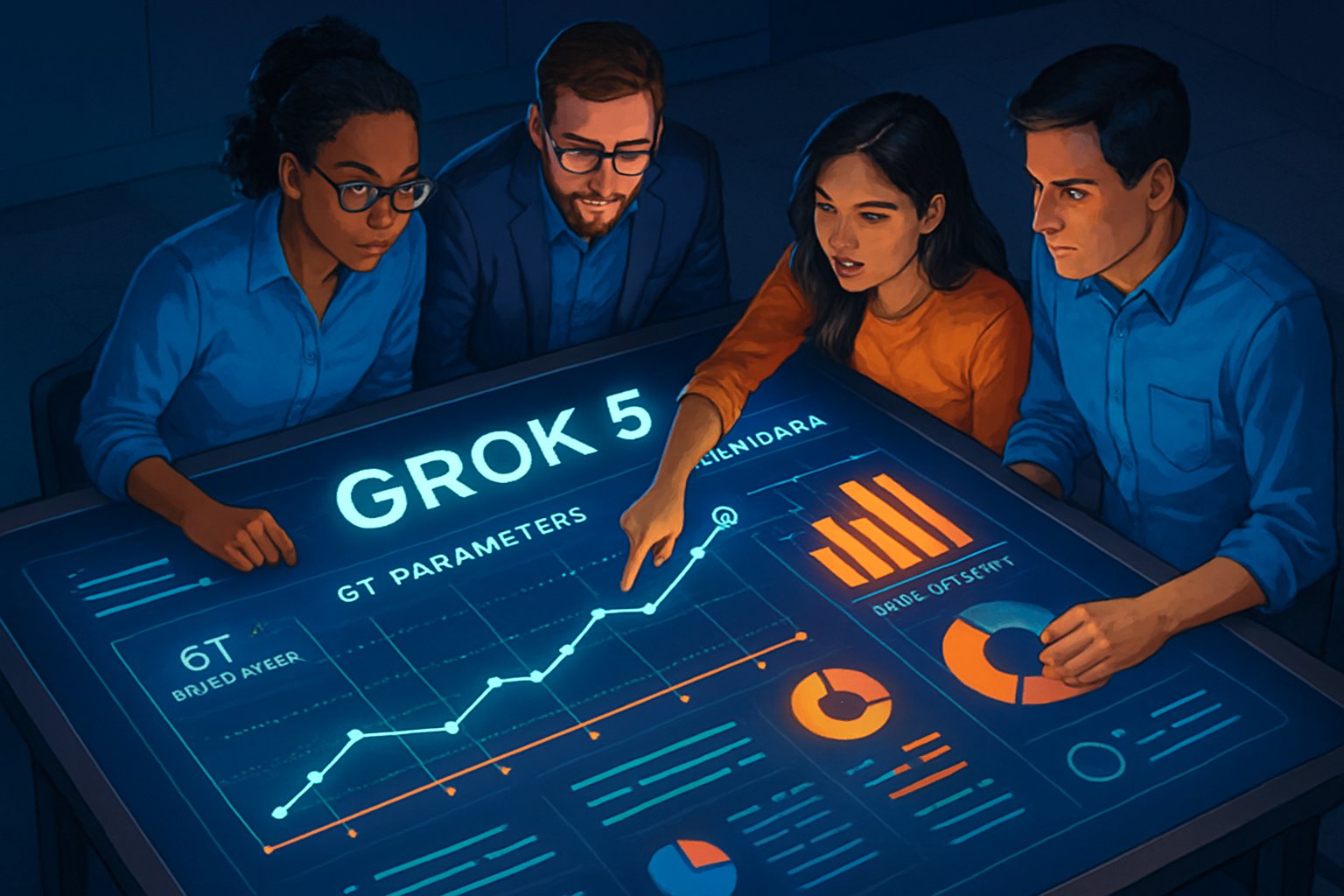
AI CERTS
1 hour ago
Grok 5 Raises Bar for Next-Gen AI Scaling in 2026 Launch

Meanwhile, the launch window shifted from late 2025 to Q1 2026, giving engineers extra runway.
Musk even assigned a 10% chance of touching AGI territory, sparking debate.
This article unpacks specifications, infrastructure, opportunities, and risks for technical leaders following Grok’s trajectory.
Grok 5 Launch Overview
Grok 5 doubles parameters relative to Grok 4, moving from three to roughly six trillion.
Therefore, model capacity reaches the reported 2x Grok 4 size threshold that Musk highlighted on stage.
Such growth aligns with next-gen AI scaling imperatives across the sector.
Moreover, Musk claimed Grok 5 will be inherently multimodal, spanning text, images, audio, and video streams.
Consequently, real-time video understanding should let the model reason across continuous frames rather than static snapshots.
Superior reasoning tools are planned to orchestrate external APIs seamlessly.
Analysts expect richer robotics and surveillance applications if latency remains low.
Grok 5 thus promises unprecedented breadth and parameter heft.
However, its benefits depend on reliable infrastructure, discussed next.
2x Grok 4 Size
The 2x Grok 4 size claim resonates because many enterprises still struggle to scale beyond trillion-level models.
Furthermore, doubling dense or sparse parameters rarely translates linearly into cost; expertise determines efficiency.
In contrast, mixture-of-experts routing can keep inference budgets manageable.
- Parameter count: ~6 trillion (reported)
- Launch window: Q1 2026
- Capability: real-time video understanding support
- AGI probability: 10% estimate
Academic literature reminds observers that parameter count alone seldom guarantees linear capability gains.
However, empirical studies show larger models often acquire emergent reasoning at specific scale thresholds.
Therefore, Grok 5’s 2x Grok 4 size may cross such thresholds when trained on curated, high-quality data.
These statistics contextualize the scale leap.
Subsequently, attention shifts toward data center readiness.
Infrastructure Scaling Drivers Explained
Colossus, xAI’s supercomputer, already hosts more than 200,000 H100 GPUs.
Additionally, Musk signaled plans to pursue GPU cluster expansion toward one million accelerators.
Such ambition underscores relentless next-gen AI scaling pressure across vendors.
However, electricity demand may exceed hundreds of megawatts, straining local grids.
Meanwhile, on-site gas turbines and batteries aim to buffer intermittent supply.
Regulators are scrutinizing environmental ramifications and community impact.
Therefore, next-gen AI scaling intensifies regional infrastructure negotiations.
GPU cluster expansion also drives novel cooling designs, from immersion baths to rear-door heat exchangers.
Consequently, capital expenditure climbs, with reports citing near-billion-dollar monthly compute bills.
Yet investors appear willing to fund capacity given potential market returns.
GPU Cluster Expansion Impact
The GPU cluster expansion narrative matters for CIOs planning budget roadmaps.
Moreover, scarce high-end silicon could delay rival projects, tilting early advantage toward xAI.
Nevertheless, procurement shocks may ripple across supply chains globally.
Therefore, portfolio managers are modeling chip availability scenarios through 2026.
- NVIDIA H100 price trend: upward pressure
- Power contracts: multi-year, fixed rates
- Cooling CAPEX: rising 25% year on year
Robust infrastructure remains prerequisite for promised capability jumps.
Consequently, attention moves to product differentiation factors.
Competitive Landscape Insights Ahead
OpenAI, Google, Meta, and Anthropic are chasing similar multimodal milestones.
However, Grok 5’s claimed real-time video understanding could offer distinct positioning.
Next-gen AI scaling underpins that advantage.
That feature may integrate seamlessly with Tesla’s sensor fleet, enabling live analytics.
Additionally, xAI touts superior reasoning tools to help developers orchestrate complex workflows.
Meanwhile, stakeholders will benchmark speed, accuracy, and cost to choose providers.
Realistic budgets still govern next-gen AI scaling choices.
Google’s Gemini roadmap emphasizes orchestration across code, images, and speech.
Furthermore, OpenAI’s projected GPT-5 aims for robust real-time video understanding using multimodal routing.
Superior reasoning tools remain a common marketing refrain across vendors, though concrete metrics vary.
Competitive differentiation rests on measured performance, not press hype.
Therefore, potential buyers demand transparent benchmarks before commitments.
Risks And Open Questions
Frontier models bring amplified safety and alignment concerns.
Consequently, European regulators may classify Grok 5 as a high-risk system requiring pre-deployment audits.
Additionally, misinformation, phishing, and deepfake possibilities scale alongside capability.
Environmental critics cite vast water and energy footprints driving carbon debates.
In contrast, Musk argues renewable offsets and efficiency gains will mitigate emissions.
Financial analysts question sustainability of rumored billion-dollar monthly outlays.
Verification gaps persist.
xAI still lacks a formal Grok 5 whitepaper detailing datasets, architecture, and evaluation methods.
Therefore, independent labs await access for MT-Bench and ARC-AGI testing.
Unchecked next-gen AI scaling could magnify misuse vectors.
Leading researchers propose interpretability dashboards to track gradient saliencies during training.
Additionally, safety teams are experimenting with constitutional guardrails to constrain model outputs.
Superior reasoning tools without matching safety layers could magnify harmful automation.
These uncertainties could delay enterprise onboarding.
However, clear documentation may arrive soon, closing confidence gaps.
Strategic Takeaways Moving Forward
Executives planning next-gen AI scaling initiatives must balance ambition with realism.
Moreover, early engagement with procurement teams can secure scarce hardware slots.
Professionals can boost expertise via the AI Engineer™ certification and design superior reasoning tools responsibly.
Additionally, budgeting scenarios should factor potential GPU cluster expansion surcharges.
Subsequently, teams can prototype modest workloads on existing Grok versions while awaiting benchmarks.
Sound governance keeps next-gen AI scaling aligned with policy.
Strategic alignment today positions firms for smoother migrations later.
Consequently, disciplined planning turns hype into tangible value.
Grok 5 exemplifies how next-gen AI scaling accelerates despite technical, financial, and regulatory headwinds.
Its projected 2x Grok 4 size, real-time video understanding, and superior reasoning tools could redefine enterprise automation.
However, verification and energy considerations remain crucial before widespread rollout.
Consequently, technology leaders should monitor benchmark disclosures, supply chain signals, and emerging compliance rules.
Meanwhile, investing in talent through the linked certification prepares teams to harness upcoming capabilities.
Take action now, evaluate pilots, and position your organization for the next frontier.



